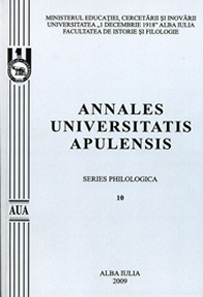The Prototype Theory and Semantic Relations in Early Child Romanian
The Prototype Theory and Semantic Relations in Early Child Romanian
Author(s): Elena BujaSubject(s): Language and Literature Studies
Published by: Universitatea »1 Decembrie 1918« Alba Iulia
Keywords: prototype; semantic relations; language acquisition; developmental path
Summary/Abstract: A child’s increasing cognitive ability is reflected, among other things, in the relationships of words expressed. The child’s pre-linguistic and oneword utterances carry communicative intentions. As multiword combinations are formed, more complex semantic relations are expressed. The present paper aims at revealing the emergence and development of the semantic relations in child Romanian and at showing the manner in which these may be affected by the concept of ‘prototype’. The sources for the data are: (1) a long term collection of random observations of Romanian children's spontaneous speech and (2) a corpus of narratives gathered for a more extensive research. Since the field of child language acquisition lends itself to interdisciplinary investigation, my aim is to find out the extent to which the concept of prototype aids children in using a variety of semantic relations and in combining them to produce longer utterances. The prototype theory was launched in the 1970s by Eleanor Rosch, a psychologist at the University of California at Berkeley. Later on, the theory moved in 2 directions: on the one hand E. Rosch’s findings were taken up by formal psycho-lexicology which tries to devise formal models for human conceptual memory and its operation; on the other hand the theory enjoyed growing success in linguistics where various people (Lakoff 1987, Taylor, 1989, Ungerer&Schmid 1996), attempted to demonstrate the existence of prototype effects at all language levels (phonology, morphology, syntax and semantics). The prototype, defined briefly as the central member of a category, can help us explain how we (adults) should deal with the flexible and dynamic nature of word meanings, and implicitly with untypical examples of semantic relations employed by pre-school children. One such semantic relation that can be explained in terms of the prototype theory is hyponymy (meaning inclusion). Early nouns tend to be exemplars of what have been called basic level categories (Ungerer & Schmid, 1999, Aitchinson, 1999). The basic level is the level on which the largest bundles of naturally correlated attributes are available for categorization (prototype). Thus, the children I investigated produced in most of the cases the superordinate term pasare (to refer to an owl that appeared in a picture-book). Some others (especially the older children, aged 5) attempted to produce the appropriate hyponym (i.e. owl), but they produced a synonymic series: vultur (‘eagle’), pupaza (‘hoopoe’). A possible explanation for the latter hyponym relied again on the prototype concept: the child must have been familiar with Ion Creanga’s famous Amintiri din copilarie (Memories of My Childhood). Thus, for this particular child, pupaza is the prototypical bird because he encountered it in this restricted context.
Journal: Annales Universitatis Apulensis. Series Philologica
- Issue Year: 11/2010
- Issue No: 2
- Page Range: 133-145
- Page Count: 13
- Language: English

